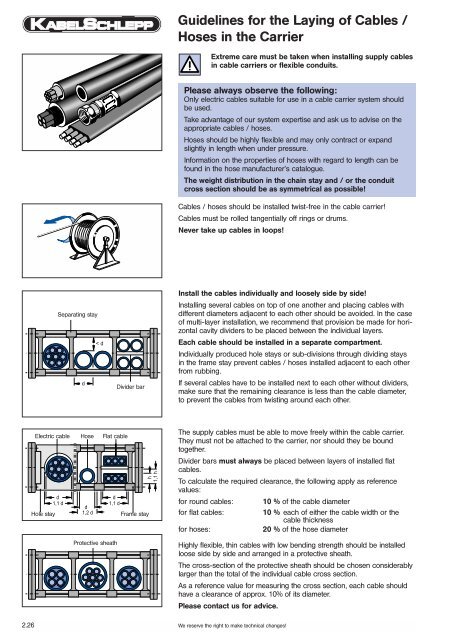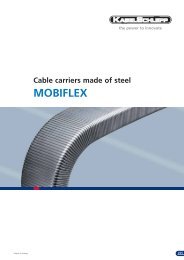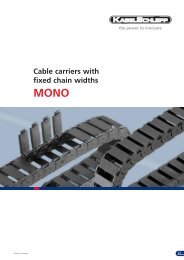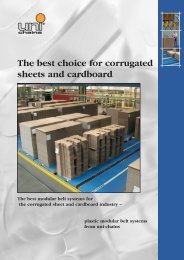- Page 1 and 2: Plastic Cable Carriers 01/2003
- Page 3 and 4: KABELSCHLEPP. . . GLOBAL STRENGTH C
- Page 5 and 6: CAD-DATA ON THE INTERNET Visit us o
- Page 7 and 8: THE RIGHT SOLUTION FOR EVERY SITUAT
- Page 9 and 10: REASONS FOR USING KABELSCHLEPP …
- Page 11 and 12: SELECTION OF CABLE CARRIER In order
- Page 13 and 14: Kabelschlepp Kabelschlepp Kabelschl
- Page 15 and 16: PRODUCT GROUP CHARACTERISTICS Cable
- Page 17 and 18: FURTHER SUPPLY PROGRAMME PROTUM ext
- Page 19 and 20: FURTHER SUPPLY PROGRAMME Steel Drag
- Page 21 and 22: Design Guidelines
- Page 23 and 24: Design Guidelines L S L f L S 2 L B
- Page 25 and 26: Design Guidelines * with restrictio
- Page 27 and 28: Design Guidelines Installation Vari
- Page 29 and 30: Design Guidelines Formulae for the
- Page 31 and 32: Design Guidelines Horizontal arrang
- Page 33 and 34: Design Guidelines Single-sided arra
- Page 35 and 36: Design Guidelines Determining the c
- Page 37 and 38: Design Guidelines Installations for
- Page 39 and 40: Design Guidelines Horizontal arrang
- Page 41 and 42: Design Guidelines Vertical arrangem
- Page 43 and 44: Design Guidelines Vertical arrangem
- Page 45: Design Guidelines Horizontal / vert
- Page 49 and 50: Plastic Cable Carriers
- Page 51 and 52: Technical Data — MONO Series Prof
- Page 53 and 54: Technical Data — MONO Series Type
- Page 55 and 56: Technical Data — MONO Series Type
- Page 57 and 58: Technical Data — MONO Series Type
- Page 59 and 60: Technical Data — MONO Series Type
- Page 61 and 62: Technical Data — MONO Series Type
- Page 63 and 64: Technical Data — MONO Series Type
- Page 65 and 66: Technical Data — MONO Series Type
- Page 67 and 68: Technical Data — MONO Series Type
- Page 69 and 70: Technical Data — MONO Series Type
- Page 71 and 72: Technical Data — MONO Series Type
- Page 73 and 74: Technical Data — MONO Series Type
- Page 75 and 76: H Technical Data — MONO Series Ty
- Page 77 and 78: Energieführungsketten aus Kunststo
- Page 79 and 80: KR 28 KR 38 KR 45 KR 60 KR 75 Techn
- Page 81 and 82: Technical Data — UNIFLEX Series T
- Page 83 and 84: Technical Data — UNIFLEX Series T
- Page 85 and 86: Technical Data — UNIFLEX Series T
- Page 87 and 88: Technical Data — UNIFLEX Series T
- Page 89 and 90: Technical Data — UNIFLEX Series T
- Page 91 and 92: KR 52 KR 125 KR 150 Technical Data
- Page 93 and 94: Technical Data — UNIFLEX Series T
- Page 95 and 96: Technical Data — UNIFLEX Series T
- Page 97 and 98:
Technical Data — UNIFLEX Series T
- Page 99 and 100:
Technical Data — UNIFLEX Series T
- Page 101 and 102:
Technical Data — UNIFLEX Series T
- Page 103 and 104:
Technical Data — UNIFLEX Series T
- Page 105 and 106:
Technical Data — UNIFLEX Series T
- Page 107 and 108:
Technical Data — UNIFLEX Series T
- Page 109 and 110:
Technical Data — UNIFLEX Series T
- Page 111 and 112:
Technical Data — UNIFLEX Series T
- Page 113 and 114:
Technical Data — UNIFLEX Series T
- Page 115 and 116:
Technical Data — UNIFLEX Series T
- Page 117 and 118:
Technical Data — UNIFLEX Series 3
- Page 119 and 120:
Technical Data — UNIFLEX Series T
- Page 121 and 122:
Technical Data — UNIFLEX Series T
- Page 123 and 124:
Energieführungsketten aus Kunststo
- Page 125 and 126:
Technical Data — K Series Type KC
- Page 127 and 128:
Technical Data — K Series Type KC
- Page 129 and 130:
Technical Data — K Series Type KC
- Page 131 and 132:
Technical Data — K Series Type KC
- Page 133 and 134:
Technical Data — K Series Type KC
- Page 135 and 136:
Technical Data — K Series Type KC
- Page 137 and 138:
Technical Data — K Series Type KC
- Page 139 and 140:
H Technical Data — K Series Type
- Page 141 and 142:
Energieführungsketten aus Kunststo
- Page 143 and 144:
Technical Data — K Series Type KE
- Page 145 and 146:
Technical Data — K Series Type KE
- Page 147 and 148:
Technical Data — K Series Type KE
- Page 149 and 150:
Technical Data — K Series Type KE
- Page 151 and 152:
Technical Data — K Series Type KE
- Page 153 and 154:
Technical Data — K Series Type KE
- Page 155 and 156:
Technical Data — K Series Type KE
- Page 157 and 158:
Technical Data — M Series Profile
- Page 159 and 160:
Technical Data — M Series Type MC
- Page 161 and 162:
Technical Data — M Series Type MC
- Page 163 and 164:
Technical Data — M Series Type MC
- Page 165 and 166:
Technical Data — M Series Type MC
- Page 167 and 168:
Technical Data — M Series Type MC
- Page 169 and 170:
Technical Data — M Series Type MC
- Page 171 and 172:
Technical Data — M Series Type MC
- Page 173 and 174:
Technical Data — M Series Type MC
- Page 175 and 176:
Technical Data — M Series Type MC
- Page 177 and 178:
Technical Data — M Series Type MC
- Page 179 and 180:
Technical Data — M Series Type MC
- Page 181 and 182:
Technical Data — M Series Type MC
- Page 183 and 184:
Technical Data — M Series Type MC
- Page 185 and 186:
Technical Data — M Series Type MC
- Page 187 and 188:
Technical Data — M Series Type MC
- Page 189 and 190:
Technical Data — M Series Type MC
- Page 191 and 192:
Technical Data — M Series Type MC
- Page 193 and 194:
Technical Data — M Series Type MC
- Page 195 and 196:
Technical Data — M Series Type MC
- Page 197 and 198:
Technical Data — M Series Profile
- Page 199 and 200:
Technical Data — M Series Type ME
- Page 201 and 202:
Technical Data — M Series Type ME
- Page 203 and 204:
Technical Data — M Series Type MK
- Page 205 and 206:
Technical Data — M Series Type MK
- Page 207 and 208:
Technical Data — M Series Type MK
- Page 209 and 210:
Technical Data — M Series Type ME
- Page 211 and 212:
Technical Data — M Series Type ME
- Page 213 and 214:
Technical Data — M Series Type ME
- Page 215 and 216:
Technical Data — M Series Type ME
- Page 217 and 218:
Technical Data — M Series Type MK
- Page 219 and 220:
Technical Data — M Series Type ME
- Page 221 and 222:
Technical Data — M Series Type ME
- Page 223 and 224:
Technical Data — M Series Type ME
- Page 225 and 226:
Technical Data — M Series Type MK
- Page 227 and 228:
Technical Data — M Series Type ME
- Page 229 and 230:
Technical Data — M Series Type ME
- Page 231 and 232:
Energieführungsketten aus Kunststo
- Page 233 and 234:
Technical Data — XL Series Type X
- Page 235 and 236:
Technical Data — XL Series Type X
- Page 237 and 238:
Technical Data — XL Series Type X
- Page 239 and 240:
Energieführungsketten aus Kunststo
- Page 241 and 242:
Technical Data — M Series Type MT
- Page 243 and 244:
Technical Data — M Series Type MT
- Page 245 and 246:
Technical Data — M Series Type MT
- Page 247 and 248:
Technical Data — M Series Type MT
- Page 249 and 250:
Technical Data — M Series Type MT
- Page 251 and 252:
Technical Data — M Series Type MT
- Page 253 and 254:
Technical Data — M Series Type MT
- Page 255 and 256:
Technical Data — M Series Type MT
- Page 257 and 258:
Technical Data — M Series Type MT
- Page 259 and 260:
Technical Data — M Series Type MT
- Page 261 and 262:
Technical Data — M Series Type MT
- Page 263 and 264:
Technical Data — M Series Type MT
- Page 265 and 266:
Technical Data — M Series Type MT
- Page 267 and 268:
Technical Data — M Series Type MT
- Page 269 and 270:
Technical Data — M Series Type MT
- Page 271 and 272:
Technical Data — M Series Type MT
- Page 273 and 274:
Type XLT Enclosed Cable Carriers wi
- Page 275 and 276:
Technical Data — XL Series Type X
- Page 277 and 278:
Technical Data — XL Series Type X
- Page 279 and 280:
QUATTROFLEX Enclosed Cable Carriers
- Page 281 and 282:
Technical Data - QUATTROFLEX Type T
- Page 283 and 284:
Technical Data - QUATTROFLEX Type T
- Page 285 and 286:
Technical Data - QUATTROFLEX Type T
- Page 287 and 288:
Technical Data - QUATTROFLEX Type T
- Page 289 and 290:
QUANTUM Cable Carrier System
- Page 291 and 292:
Technical Data - QUANTUM-Series Typ
- Page 293 and 294:
Technical Data - QUANTUM-Series Typ
- Page 295 and 296:
Technical Data - QUANTUM-Series Typ
- Page 297 and 298:
Technical Data - QUANTUM-Series Typ
- Page 299 and 300:
Technical Data - QUANTUM-Series Typ
- Page 301 and 302:
Technical Data - QUANTUM-Series Typ
- Page 303 and 304:
Technical Data - QUANTUM-Series Typ
- Page 305 and 306:
Technical Data - QUANTUM-Series Typ
- Page 307 and 308:
Technical Data - QUANTUM-Series Typ
- Page 309 and 310:
Technical Data - QUANTUM-Series Typ
- Page 311 and 312:
Technical Data - QUANTUM-Series Typ
- Page 313 and 314:
Technical Data - QUANTUM-Series Typ
- Page 315 and 316:
Technical Data - QUANTUM-Series Typ
- Page 317 and 318:
Technical Data - QUANTUM-Series Typ
- Page 319 and 320:
Technical Data - QUANTUM-Series Typ
- Page 321 and 322:
Technical Data - QUANTUM-Series Typ
- Page 323 and 324:
CONDUFLEX Flexible Energy Conduits
- Page 325 and 326:
Technical Data - CONDUFLEX CONDUFLE
- Page 327 and 328:
Technical Data - CONDUFLEX CONDUFLE
- Page 329 and 330:
System Components Support Tray One-
- Page 331 and 332:
System Components Guide Channels Gu
- Page 333 and 334:
System Components Explanation of Te
- Page 335 and 336:
System Components Loop Overhang Ü
- Page 337 and 338:
System Components Further possible
- Page 339 and 340:
System Components M-Series When cal
- Page 341 and 342:
System Components Table of Dimensio
- Page 343 and 344:
System Components Fixing Options fo
- Page 345 and 346:
Electric Cables Fully harnessed Sys
- Page 347 and 348:
System Components Positioning of th
- Page 349 and 350:
System Components Positioning of th
- Page 351 and 352:
System Components Fitting Instructi
- Page 353 and 354:
System Components Strain Relief Ele
- Page 355 and 356:
System Components Strain Relief Ele
- Page 357 and 358:
Interesting Technical Information R
- Page 359 and 360:
Interesting Technical Information C
- Page 361 and 362:
Interesting Technical Information
- Page 363 and 364:
Interesting Technical Information T
- Page 365 and 366:
Interesting Technical Information F
- Page 367 and 368:
Interesting Technical Information T
- Page 369 and 370:
Interesting Technical Information B
- Page 371 and 372:
Interesting Technical Information C
- Page 373 and 374:
Appendix
- Page 375 and 376:
Application Examples Type 0450 Cabl
- Page 377 and 378:
Application Examples Cable Carrier
- Page 379 and 380:
Application Examples Type KC 0650 C
- Page 381 and 382:
Application Examples Type 0450 and
- Page 383 and 384:
Application Examples KC-Series Cabl
- Page 385 and 386:
Application Examples Type 0625 Cabl
- Page 387 and 388:
Application Examples CONDUFLEX Flex
- Page 389 and 390:
8.16 Sketches / Notes
- Page 391 and 392:
8.18 Sketches / Notes
- Page 393 and 394:
FAX-Order Form for Plastic Cable Ca
- Page 395 and 396:
Sketches / Notes 8.22 We reserve th
- Page 397 and 398:
Sales Network KABELSCHLEPP GMBH D-5
- Page 399:
KABELSCHLEPP GMBH Marienborner Str.







